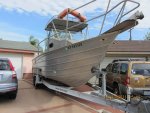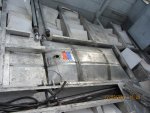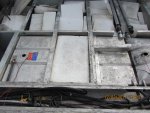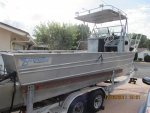Re: Fuel tank explosion (see picture). Why??
I'm missing something. How does a strip of rubber (a non-conductive material) ground the forklift? I'm not being critical I would just like some explanation so I can learn something.
The rubber strip spoken of often has a metal impregnation and provides a grounding path for static electricity to get to earth ground. Static electricity collects on non conductive surfaces, and dragging a metalized rubber strip on the ground brings a statically charged surface of many thousands of volts down to ground potential of zero volts, hence, the surface charge of the boat and it's parts is the same as earth ground. Better for the rubber strip to do it instead of you, or a ladder touching a statically electrically charged boat with several thousand volts on it's surfaces with an electrical bonding anomaly on the fuel tank. Anyone remember all of the cars and trucks back in the fifties that had rubber strips dragging on the ground? Helicopters are amazing collectors of static charges. If you ever grab the skids of a helicopter before it touches ground in the kind of weather that this happened in, you will be knocked on your rear so bad you won't know what happened because of the speed of the rotor blades whizzing through the air. Static charges are an amazing thing.
The more I think about it, bonding is key. If it were properly bonded, the charged surface of the boat would go from the boat's hull directly to the ladder and the tank would have never seen a problem. With the tank being able to be at a different electrical potential than the hull, any close proximity conductor to a surface of a different voltage potential could be a spark maker. This would be possible if the quantity sender were loose, creating some sort of "make and break" situation possible. The metalized rubber static discharge strip dragging on the ground would be a great idea as long as the boat's parts are bonded to each other, tank parts and connections are tightly snug and in proper position, the boat is bonded to the trailer and the trailer is bonded to the metalized rubber strip touching earth ground.
Next, check the vents. I had and Aerostar 601 in my care one time that had a plugged tank vent. The aircraft was fueled full, and then the fuel warmed up and split the tank along the entire length of it's aluminum welded seam. Made a big mess and it cost thousands to fix, back in the eighties.
























